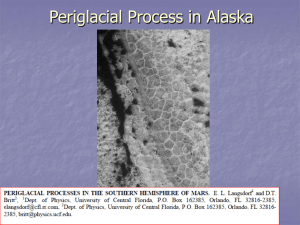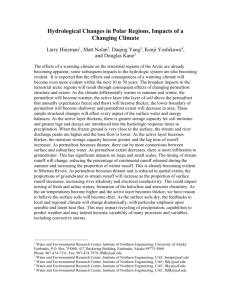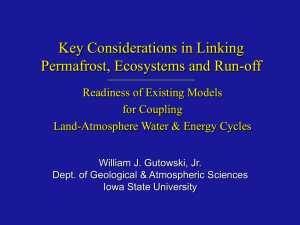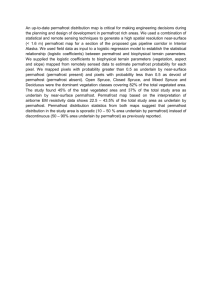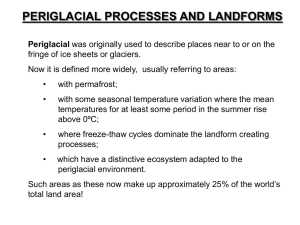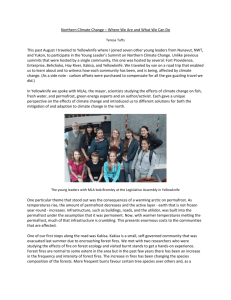North Slope permafrost thawing sooner than expected
advertisement
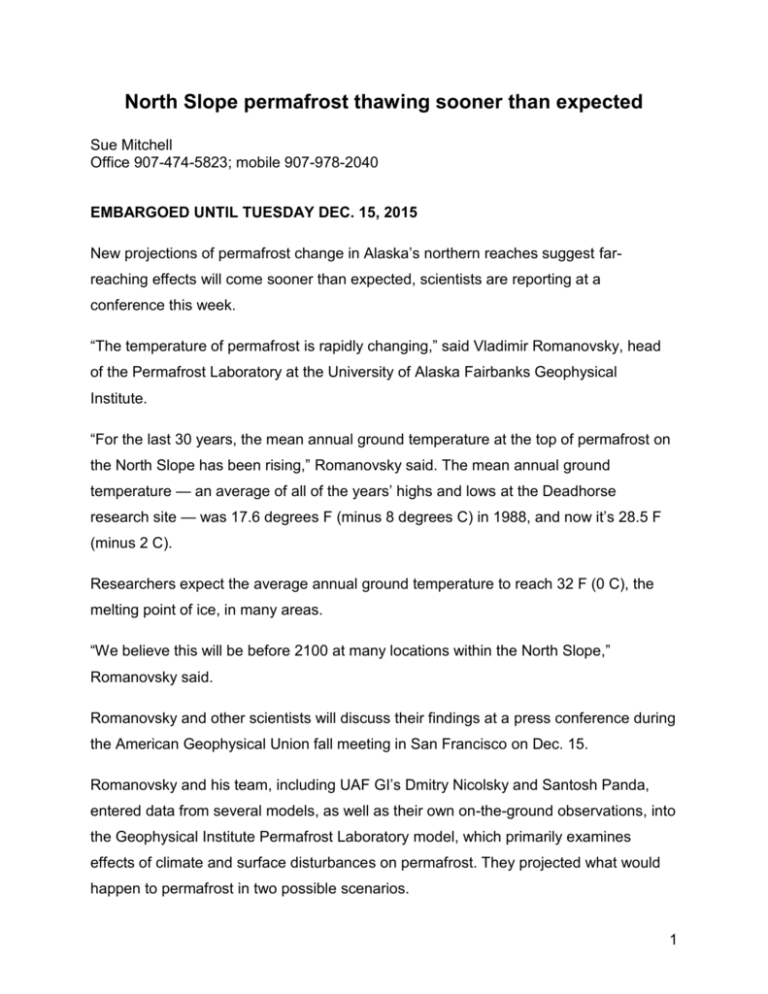
North Slope permafrost thawing sooner than expected Sue Mitchell Office 907-474-5823; mobile 907-978-2040 EMBARGOED UNTIL TUESDAY DEC. 15, 2015 New projections of permafrost change in Alaska’s northern reaches suggest farreaching effects will come sooner than expected, scientists are reporting at a conference this week. “The temperature of permafrost is rapidly changing,” said Vladimir Romanovsky, head of the Permafrost Laboratory at the University of Alaska Fairbanks Geophysical Institute. “For the last 30 years, the mean annual ground temperature at the top of permafrost on the North Slope has been rising,” Romanovsky said. The mean annual ground temperature — an average of all of the years’ highs and lows at the Deadhorse research site — was 17.6 degrees F (minus 8 degrees C) in 1988, and now it’s 28.5 F (minus 2 C). Researchers expect the average annual ground temperature to reach 32 F (0 C), the melting point of ice, in many areas. “We believe this will be before 2100 at many locations within the North Slope,” Romanovsky said. Romanovsky and other scientists will discuss their findings at a press conference during the American Geophysical Union fall meeting in San Francisco on Dec. 15. Romanovsky and his team, including UAF GI’s Dmitry Nicolsky and Santosh Panda, entered data from several models, as well as their own on-the-ground observations, into the Geophysical Institute Permafrost Laboratory model, which primarily examines effects of climate and surface disturbances on permafrost. They projected what would happen to permafrost in two possible scenarios. 1 A moderate scenario assumes worldwide carbon dioxide emissions will continue to decline at the modest rate they are now. This will lead to carbon dioxide levels in the Earth’s atmosphere leveling off by roughly 2050 and staying constant until the end of the century. “In this scenario we will see substantial thawing of permafrost on Alaska’s North Slope, but only in certain areas, particularly the foothills north of the Brooks Range,” Romanovsky said. The extreme scenario assumes worldwide carbon dioxide emissions continue at today’s rates. In that case, permafrost thawing on the North Slope will be much more significant and will extend beyond the foothills and into the Arctic coastal plain, Romanovsky said. In this outcome, the results at 2050 would be similar to the outcome in the moderate scenario, but after 2050 permafrost thawing would accelerate. More than half of the permafrost on the North Slope will be thawing by 2100 in this scenario. “Under these conditions, the permafrost will become unstable beneath any infrastructure such as roads, pipelines and buildings,” Romanovsky said. “The result will be dramatic effects on infrastructure and ecosystems.” “All the engineering solutions (to allow oil production on Alaska’s North Slope) were designed and infrastructure was built when the permafrost was much colder,” Romanovsky said. “When it reaches the (thawing) threshold, it will be very difficult to keep all the infrastructure running.” Santosh Panda, research associate at the UAF Geophysical Institute, will report at AGU on his work with the National Park Service to produce high-resolution maps of likely permafrost change in Alaska’s national parklands. He has completed work on the projections for 2050 and 2100 for the five Arctic national parks: Gates of the Arctic National Park and Preserve, Noatak National Preserve, Kobuk Valley National Park, Cape Krusenstern National Monument and Bering Land Bridge National Preserve. These five parklands total 20 million acres, about the size of South Carolina. The 40 2 million acres of Alaska’s NPS lands that lie within the areas affected by permafrost constitute nearly half of all the NPS-administered lands in the United States. The release of carbon from thawing permafrost has been discussed widely, Panda said, but he thinks the resulting landscape changes on Alaska’s North Slope will be more important in the near future. “If there is thawing, the ice-rich soils are going to change dramatically,” Panda said. “Permafrost degradation is going to touch the whole landscape through changes in water distribution, slope failures and changes in vegetation that will affect wildlife habitat and the aesthetic value of the parks.” The NPS will be interested in ways to minimize or manage those changes, Panda said. The agency wants to know how the changes affect wildlife, their migration patterns and the people who depend on those animals, Panda said. Kevin Schaefer, a research scientist at the National Snow and Ice Data Center at the University of Colorado Boulder, said the United States needs a permafrost forecasting system. “There is a huge demand for better information about permafrost,” said Schaefer, who also will participate in the news conference . “For example, people who maintain and build infrastructure in Alaska need to know what the thaw depth is going to be so they can plan.” Scientists currently assess permafrost conditions in certain areas, but these projects are “one-time deals,” according to Schaefer. “They often can’t repeat it because they need resources like money and time,” he said. “What we need is an operational forecast that occurs every year — projecting out at least one year but probably up to a decade,” Schaefer said. The forecasting system would predict the permafrost’s active layer thickness, or thaw depth, and its temperature at a specified depth. Additional monitoring stations would also need to be installed throughout Alaska, the only state with territory north of the Arctic Circle. 3 The press conference will be on Tuesday, Dec. 15, at 2:30 p.m. Pacific Time at the 2015 fall meeting of the American Geophysical Union in San Francisco. It will be streamed online at http://fallmeeting.agu.org/2015/media-center/web-streaming/. For more information about the press conference, contact AGU Public Information Manager Nanci Bompey, 202-777-7524 or nbompey@agu.org. ### ON THE WEB: http://permafrost.gi.alaska.edu/ ADDITIONAL CONTACTS: Vladimir Romanovsky, UAF Geophysical Institute, 907-474-7459, veromanovsky@alaska.edu Dmitry Nicolsky, UAF Geophysical Institute, 907-474-7397, djnicolsky@alaska.edu Santosh Panda, UAF Geophysical Institute, 907-474-7539, skpanda@alaska.edu Kevin Schaefer, National Snow and Ice Data Center, University of Colorado, 303-4928869, kevin.schaefer@nsidc.org 4

